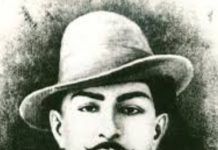A new play bravely traces the genius of Ramanujan, but does it thicken the mist around mathematics it wanted to clear, asks Aastha Atray Banan

IF YOU’RE the type that puts the numb in numbers, if you ever sat in math class convinced that every passing moment was draining the very soul out of you — Simon McBurney’s play, A Disappearing Number will be nothing short of a revelation. Recently staged in Mumbai by the UK-based theatre group Complicite, the plot of the story explores the unusual relationship between the legend Srinivasa Ramanujan and Cambridge University don GH Hardy.
In spite of his negligible formal training, Ramanujan is legendary for his contributions to mathematical analysis, number theory, infinite series and continued fractions — in short, he was what present-day mathgroupies would describe as a rockstar. For arithmophobes, the non-linear narrative locates math in a place one would never imagine — as art.
As the play weaves through different time zones and spaces — from Chennai’s bustling streets to Cambridge’s quiet surroundings — it describes Ramanujan’s life through music, dance and a continuous exchange of emotions through eras. “I guess the story could not be told in a linear way because not much is known about Ramanujan’s life, apart from his mathematics. In many ways, it defines him. One could almost say it engulfed him,” says Mrudul Bapat, a professor of mathematics who took students from her BSc class to watch the play.
Although Bapat hopes that the experience will result in a renewed zest for the subject in her students, she also feels that the production mystifies math too much. “He was a genius. His math was based entirely on intuition. He hardly ever needed to put his calculations on paper. So it was quite literally like creating formulae out of the thin air,” she says, adding with a pause, “But that doesn’t mean all mathematicians are like that.”
THE MAIN body of work is interspersed with the presentday story of a globe-trotting Indian-American businessman, and his math-lecturer partner. The partner travels to India in search of Ramanujan’s legacy and eventually dies in his land of birth. British actor David Annen, who plays the role of Hardy, finds the race dynamic of the story more interesting, “Hardy never saw Ramanujan as black or white or brown. He just saw his genius and in a way he discovered him. That’s why he described it as the one ‘romantic incident’ of his life. Even the modern-day love story is so touching that it will reach out to each member of the audience.”
For McBurney, who describes math as ‘the only real thing in the world’, the subject is automatically enveloped in an aura of mystique. When Ramanujan, who starts out as a poor south Indian Brahmin, says, ‘It seemed as if Narasimha was tearing out math from my guts’, the viewer can almost see the creative torpor involved in the creation of something as drab as a theorem. “Math is not unlike poetry or art, it involves seeing patterns in abstraction. But to appreciate its ultimate beauty, you still need to practice those formulae!” laughs Bapat.













